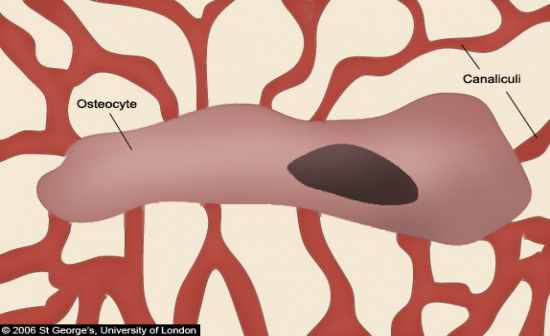Cards In This Set
| Front | Back |
|
2 divisions of skeletal system
|
Axial skeleton: skull, vertebral column, ribs
Appendicular skeleton: limbs and girdles |
|
5 Functions of bones
|
1. Support
2. Protection 3. Movement 4. Storage 5. Blood cell formation |
|
How many bones in adult skeleton?
|
206
|
|
2 types of bone tissue and their classification:
|
Compact bone: dense, smooth
Spongy bone: needlelike pieces, open space |
|
4 bone classifications, their characteristics, and an example in the body:
|
1. Long bones
-long shaft made of compact bone with heads at both ends. -humerus, femur 2. Short bones -cube-shaped, mostly spongy bone -wrist and ankle 3. Flat bones -thin, flat, curved, spongy bone sandwiched between two layers of compact bone -skull, ribs, sternum 4. Irregular bones -do not fit any other categories -vertebrae, hip bones |
|
What is a sesamoid bone?
|
A special type of short bone that forms within tendons, ex: patella
|
|
What is the hyoid bone?
|
An irregular bone that is associated with, but not part of, the skull, and is the only bone in the body that does not articulate with any other bone.
|
|
(Anatomy of a Long Bone)
2 sections of a long bone, characteristics: |
1. Diaphysis: bone shaft, compact bone, covered by fibrous tissue membrane called periosteum.
2. Epiphysis (proximal and distal): heads of long bone, thin layer of compact bone enclosing spongy bone, covered by articular cartilage to reduce friction at joint surfaces. |
|
Periosteum vs. Articular cartilage
|
Periosteum covers the diaphysis, where as articular cartilage covers the epiphyses
|
|
What is yellow marrow and where is it found?
|
Yellow bone marrow is adipose tissue and it is stored in the cavity of a bone shaft.
|
|
What is red marrow and where is it found?
|
Red marrow is necesary to produce blood cells; in infants it is found in the bone shaft, but in adults it is confined to the cavities of spongy bone.
|
|
What are bone markings?
|
Bumps, holes, and ridges along bone surfaces where muscles, tendons, and ligaments were attached.
|
|
Two categories of bone markings and their characteristics:
|
1. Projections/Processes: grow out from bone surface
2. Depressions/Cavities: indentations in the bone |
|
(Structure of Compact Bone)
Define Osteocytes |
 Mature bone cells found within the lacunae. |
|
(Structure of Compact Bone)
Define Lacunae |
Cavities within compact bone that house osteocytes.
|



